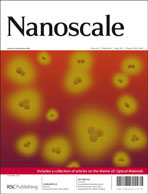Toward quantitatively fluorescent carbon-based “quantum” dots
Abstract
Carbon-based “quantum” dots (or “carbon dots”) are generally defined as surface-passivated small carbon

- This article is part of the themed collection: Optical Materials

 Please wait while we load your content...
Please wait while we load your content...